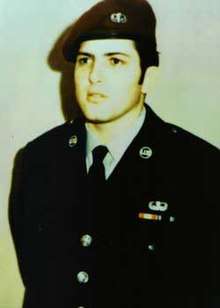Larry W. Maysey
Sergeant Larry Wayne Maysey (May 18, 1946 – November 9, 1967) was a United States Air Force pararescueman who was posthumously awarded the Air Force Cross, the Air Force's second-highest decoration (after the Medal of Honor).
Larry Wayne Maysey | |
|---|---|
 Sgt Larry Wayne Maysey | |
| Born | May 18, 1946 Chester Borough, New Jersey, U.S. |
| Died | November 9, 1967 (aged 21) in Laos |
| Allegiance | |
| Service/ | |
| Years of service | 1966–1967 |
| Rank | |
| Unit | |
| Battles/wars | Vietnam War † |
| Awards | |
Maysey grew up in Chester Borough, New Jersey and graduated from West Morris Central High School.[1]
On 8 November 1967 two HH-3E Jolly Green Giants of the 37th Aerospace Rescue and Recovery Squadron were launched on a night mission to extract five survivors of a Special Forces reconnaissance team. The site was known to be hot, surrounded by a well-disciplined, People's Army of Vietnam (PAVN) battalion. A Vietnamese Air Force (VNAF) and a United States Army helicopter had already been shot down and destroyed. Illuminated by a C-130 Hercules flare ship dropping LUU-2 parachute flares, Jolly 29 made a pickup of three survivors before being driven off by intense enemy fire. Jolly 29, with heavy battle damage, landed at the USMC Khe Sanh Combat Base. Maysey's helicopter Jolly 26 then attempted to pick up the remaining two survivors, both now wounded. Fighting, both in the air and on the ground, was intense. Maysey jumped from the safety of Jolly 26, and ran down a steep slope rescuing the two remaining men. Jolly 26 was now being hit with small arms fire. Just after Maysey had helped both survivors safely on board, a rocket propelled grenade struck the number one engine, fatally crippling the craft. The engine exploded, inverting the aircraft, which rolled and skidded down a deep ravine and burst into flames; a pilot and one other man survived the crash. Maysey received the Air Force Cross posthumously. The pilot Captain Gerald Young was rescued later that day and subsequently awarded the Medal of Honor.[2]
Air Force Cross citation
Sergeant Larry W. Maysey distinguished himself by extraordinary heroism in connection with military operations against an opposing armed force as an HH-3E Rescue Specialist in Southeast Asia on 9 November 1967. On that date, Sergeant Maysey attempted the night extraction of a ground reconnaissance team after his helicopter had been severely damaged. Two other helicopters had been shot down and a third extensively damaged in previous attempts. During the rescue attempt, Sergeant Maysey unhesitatingly exposed himself to the hail of hostile fire to assist wounded survivors into the helicopter. The hostile forces closed in quickly, and as the damaged helicopter departed, it was shot down. Through his extraordinary heroism, superb airmanship, and aggressiveness in the face of the enemy, Sergeant Maysey reflected the highest credit upon himself and the United States Air Force.
References
- Arentowicz, Terry P. That Empty Feeling: The Real Story of One 72-Hour Rescue Mission Into Laos, p. 66. AuthorHouse, 2013. ISBN 9781491836262. Accessed November 6, 2017. "The youngest member of Young's crew was Sergeant Larry W. Maysey. The Pararescue specialist had graduated from West Morris Regional High School in Chester, New Jersey, only two years prior to being sent to Viet Nam."
- The Pararescue Association. (1996).Sergeant Larry W. Maysey pg. 106: Fine Books Publishing Company, LLC Charlotte, NC. Library of Congress Number: 94-061879
External links
- Air Force Link entry: PJ Chief Master Sergeant Duane D. Hackney
- Air Force Link entry: PJ Airman First Class William H. Pitsenbarger
- Air Force Link entry: PJ Technical Sgt. Tim Wilkinson
- United States Air Force Pararescue Association
- A1C Bill Pitsenbarger posthumously awarded Medal of Honor for actions in Vietnam in 1966
- POW/MIA Remembrance Page for Larry Wayne Maysey